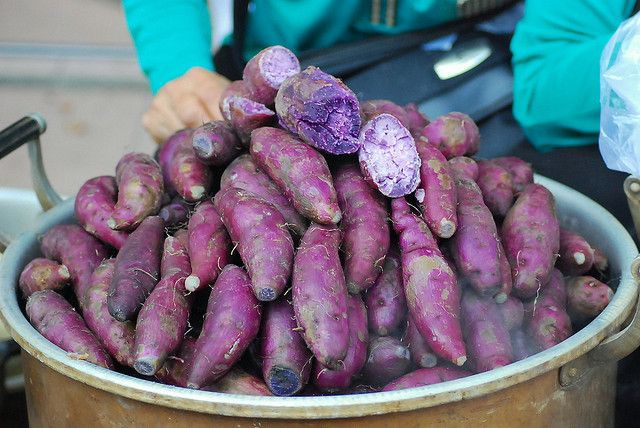Purple Sweet Potato Pigments Could Be Used To Color Foods; Replacing Synthesized Dyes And Bugs

Last year, Starbucks stopped using cochineal extract to make its frappuccinos pink. In July, it was reported that Dannon yogurt was also using the extract, which is made from crushed up cochineal beetles, to color some of its yogurts. The extract, along with other synthesized food coloring — shades of red, mostly — have long been used to color foods. A recent push by the public, however, for food makers to use natural sources of food coloring, has had researchers testing different methods for pigmentation, and now they’ve found at least one answer: purple sweet potatoes.
Food makers know that vibrant foods attract consumers. Bright red, for example, has been shown to enhance the consumer’s belief that the food is sweet, and tests showed that the coloring of beverages and sherbets did more for the consumer’s perception of flavor than the flavor itself. While consumers may love these colors, and food makers surely want to make every effort to sell their product, many consumers have been concerned about the health-related consequences synthesized food coloring could have on their children. Moreover, vegetarians must always be aware of whether or not the food they’re eating has cochineal extract.
This is where natural food coloring comes in. Researchers at Texas A&M University have been learning how to extract pigments from certain root crops, such as black or purple carrots and purple sweet potatoes, which are grown specifically for food coloring.
“The natural colors industry for foods and beverages is gaining in value as U.S. and international companies move toward sustainable and affordable crop alternatives to synthetic red colors and red colors derived from insects,” Dr. Stephen Talcott, a food chemist at Texas A&M who spoke at a press conference at the American Chemical Society National Meeting & Exposition, said in a statement. “In addition to adding eye appeal to foods and beverages, natural food colorings add natural plant-based antioxidant compounds that may have a beneficial effect on health.”
Purple Sweet Potatoes contain the pigment anthocyanin, which is also found in concord grapes and raspberries, however, they don’t come with the bitter flavor — their flavor is pretty neutral — that comes from a grape’s tannins, according to NPR. Their “tremendous” color stability allows them to color a wide range of foods, from light pink to rose colors, and red to deep purple.
The only problem with purple sweet potatoes is that their hard texture makes it difficult to extract the pigments. Furthermore, very few farmers in the U.S. grow purple sweet potatoes, causing the price of its dye to go for about $136 per pound. But as more consumers check food labels, the food industry might be pushed to grow such crops in the U.S., Dr. Talcott said. Most domestically grown purple sweet potatoes aren’t used for dyes.
Anthocyanin pigments also have mildly anti-inflammatory and anti-carcinogenic properties, Dr. Talcott said. A 2009 study also showed that they may attach to the same parts of the brain as marijuana, Discovery News reported, however, doctors haven’t found evidence that these antioxidants can get past the digestive system.



























